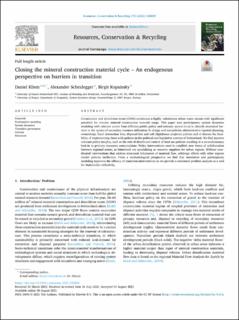| dc.contributor.author | Kliem, Daniel | |
| dc.contributor.author | Scheidegger, Alexander | |
| dc.contributor.author | Kopainsky, Birgit | |
| dc.date.accessioned | 2022-03-18T14:39:33Z | |
| dc.date.available | 2022-03-18T14:39:33Z | |
| dc.date.created | 2021-09-16T11:12:26Z | |
| dc.date.issued | 2021 | |
| dc.identifier.issn | 0921-3449 | |
| dc.identifier.uri | https://hdl.handle.net/11250/2986260 | |
| dc.description.abstract | Construction and demolition waste (CDW) constitutes a highly voluminous urban waste stream with significant potential for circular mineral construction material usage. This paper uses participatory system dynamics modeling with relevant actors from different public policy and industry sectors to a) to identify structural barriers to the uptake of secondary resource utilization; b) design and test policies administrative (spatial planning, ownership), fiscal (extraction levy, disposal fee) and soft (lighthouse projects) policies and c) discuss the feasibility of implementing these with policies in the political and legislative context of Switzerland. We find practice relevant policy insights, such as the role of distributed control of land use policies resulting in a co-evolutionary lock-in to primary resources consumptions. Policy interventions need to establish new forms of collaboration between regional actors, as hinterland are specializing as resource suppliers for urban regions. Without coordinated interventions that address structural imbalances of material flow, arbitrage effects with other regions render policies ineffective. From a methodological perspective we find that simulation and participatory modeling improves the efficacy of transition interventions as we provide a structural problem analysis as a tool for Stakeholder reflexivity. | en_US |
| dc.language.iso | eng | en_US |
| dc.publisher | Elsevier | en_US |
| dc.rights | Navngivelse 4.0 Internasjonal | * |
| dc.rights.uri | http://creativecommons.org/licenses/by/4.0/deed.no | * |
| dc.title | Closing the mineral construction material cycle – An endogenous perspective on barriers in transition | en_US |
| dc.type | Journal article | en_US |
| dc.type | Peer reviewed | en_US |
| dc.description.version | publishedVersion | en_US |
| dc.rights.holder | Copyright 2021 the authors | en_US |
| dc.source.articlenumber | 105859 | en_US |
| cristin.ispublished | true | |
| cristin.fulltext | original | |
| cristin.qualitycode | 1 | |
| dc.identifier.doi | 10.1016/j.resconrec.2021.105859 | |
| dc.identifier.cristin | 1934825 | |
| dc.source.journal | Resources, Conservation and Recycling | en_US |
| dc.identifier.citation | Resources, Conservation and Recycling. 2021, 175, 105859. | en_US |
| dc.source.volume | 175 | en_US |

